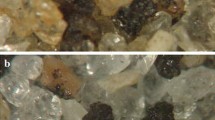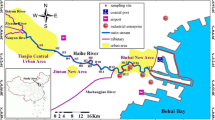Abstract
This study investigated the concentrations and potential toxicity of polycyclic aromatic hydrocarbons (PAHs) associated with highway runoff into adjacent estuarine wetlands from road segments representing three levels of average daily traffic (ADT): low (<5,000 ADT), moderate (10,000–15,000 ADT), and high use (>25,000 ADT) based on SC Department of Transportation data. Sediments from three estuarine wetland habitats (tidal creeks, Spartina marsh, and mud flats) adjacent to these road segments were sampled to represent nine highway use class/habitat type combinations. Surficial sediments were collected at 3, 25, and 50 meters from the upland/wetland interface along transects established perpendicular to the road at each site, with additional samples taken from the road berm. Average PAH concentrations, representing 25 compounds, ranged from 3.9 to 11,000 ng/g dry weight. Berm samples had significantly greater total PAH concentrations than samples taken in any of the wetland habitats. Average total PAH concentrations decreased with increasing distance from the road berm within the wetland habitats sampled, but the differences were not statistically significant. Average total PAH concentrations also were not significantly different among the wetland habitats compared. Analysis of PAH profiles indicated that the PAH source was dominated by pyrogenic combustion products rather than from petrogenic sources. This, combined with the presence of dibenzothio-phene, which is a tire oxidation product, indicated that the primary source of PAHs was related to vehicles. Two sites with total PAH concentrations exceeding published bioeffects levels were resampled for bioassay tests using the amphipod Ampelisca verrilli, the polychaete Streblospio benedicti, and the clam, Mercenaria mercenaria, with the first two assays conducted under UV lighting since previous studies had demonstrated enhanced UV toxicity of PAHs for these species. No toxicity was observed in the amphipod or polychaete assays. Toxicity was observed in the juvenile clam assay at one site, possibly due to the combined effects of PAHs and other contaminants present.



Similar content being viewed by others
References
ASTM. 1993. ASTM standards on aquatic toxicology and hazard evaluation. sponsored by ASTM Committee E-47 on biological effects and environmental fate ASTM Publication Code Number (PCN): 03-547093-16. 538 p
ASTM 1996. Standard guide for conducting sediment toxicity tests with marine and estuarine polychaetous annelids. E1611-94. 1996 Annual Book of Standards, Section 11 Water and Environmental Technology, Biological effects and environmental fate; biotechnology; pesticides ASTM, Philadelphia, Vol. 11.05, pp 1046–1069
Fortner AR, Sanders M, Lemire SW (1996) Polynuclear aromatic hydrocarbon and trace metal burdens in sediment and the oyster, Crassostrea virginica Gmelin, from two high-salinity estuaries in South Carolina. In: Vernberg FL, Vernberg WB, Siewicki T, (eds) Sustainable development in the southeast coastal zone. University of South Carolina Press, Columbia, SC, pp 445–476
Fulton MS, Scott GI, Key PB, Chandler GT, Van Dolah RF, Maier PP (1999) Comparative toxicity testing of selected benthic and epibenthic organisms for the development of sediment quality test protocols. U.S. Environmental Protection Agency, Office of Research and Development, EPA/600/R-99/085. 51 p
Hyland JL, Van Dolah RF, Snoots TR (1999) Predicting stress in benthic communities of southeastern U.S. estuaries in relation to chemical contamination of sediments Environ Toxicol Chem 18:2557–2564
Kucklick JR, Sivertsen SK, Sanders M, Scott GI (1997) Factors influencing polycyclic aromatic hydrocarbon distributions in South Carolina estuarine sediments J Exp Marine Biol Ecol 213:13–29
Long ER, MacDonald DD, Smith SL, Calder FD (1995) Incidence of adverse biological effects within ranges of chemical concentrations in marine estuarine sediments Environ Manage 19:81–97
Maltby L, Forrow DM, Boxall ABA, Calow P, Betton CI (1995) The effects of motorway runoff on freshwater ecosystems: 1. Field study Environ Toxicol Chem 14:1079–1092
Monson PD, Ankley GT, Kosian PA (1995) Phototoxic response of Lumbriculus variegates to sediments contaminated by polycyclic aromatic hydrocarbons Environ Toxicol Chem 14:891–894
National Oceanic and Atmospheric Administration (NOAA) (1998). Population: distribution, density and growth by Thomas J. Culliton. NOAA’s State of the Coast Report. NOAA, Silver Spring, MD (on-line)
Ngabe B, Bidleman TF, Scott GI (2000) Polycyclic aromatic hydrocarbons in storm runoff from urban and coastal South Carolina Sci Total Environ 255:1–9
Pelletier MC, Burgess RM, Ho KT, Kuhn A, McKinney RA, Ryba SA (1997) Phototoxicity of individual polycyclic aromatic hydrocarbons and petroleum to marine invertebrate larvae and juveniles Environ Toxicol Chem 16:2190–2199
Plumb RH Jr (1981) Procedures for handling and chemical analyses of sediment and water samples. Tech. Rept. EPA ICE-81-1 prepared by Great Lakes Laboratory, State University College at Buffalo, NY, for the U.S. Environmental Protection Agency/Corps of Engineers Technical Committee on Criteria for Dredge and Fill Material. U.S. Army Engineer Waterways Experiment Station, Vicksburg, MS
Riekerk GHM, Van Dolah RF, Levisen MV, Sanger DM, Scott GI, Bearden D, Sivertsen S, Chung K, Fulton MH (2003) An evaluation of polycyclic aromatic hydrocarbon (PH) runoff from highways into estuarine wetlands of South Carolina. Final Report submitted to South Carolina Department of Transportation, Environmental Management Office, Columbia, SC. 44 p 29202
Ringwood AH, Keppler CJ (1998) Seed clam growth: An alternative sediment bioassay development during EMAP in the Carolinian Province Environ Monitor Assess 51:247–257
Sanders M, Sivertsen S, Scott G. 2002. Origin and distribution of polycyclic aromatic hydrocarbons in surficial sediments from the Savannah River Arch Environ Contam Toxicol 43:438–448
Sanger DM, Holland AF, Scott GI. 1999. Tidal creek and salt marsh sediments in South Carolina coastal estuaries. II. Distribution of organic contaminants Arch Environ Contam Toxicol 37:458–471
Swartz RC, Ferrara SP, Lamberson JO, Cole FA, Ozretich RJ, Boese BL, Schults DW, Behrenfeld M, Ankley GT (1997) Photoactivation and toxicity of mixtures of polycyclic aromatic hydorcarbon compounds in marine sediment Environ Toxicol Chem 16:2151–2157
U.S. EPA. 2003. Procedures for the derivation of equilibrium partitioning sediment benchmarks (ESBs) for the protection of benthic organisms: PAH mixtures. EPA-600-R-02-013. Office of Research and Development. Washington, DC 20460
Weinstein JE (1996) Anthropogenic impacts on salt marshes. IN: F.J. Vernberg W.B. Vernberg T. Siewicki. Eds: Sustainable development in the southeastern coastal zone. University of South Carolina Press, Columbia, SC. pp 135–170
Weinstein JE, Sanger DM (2003) Comparative tolerance of two estuarine annelids to fluoranthene under normoxic and moderately hypoxic conditions Marine Environ Res 56:637–648
Acknowledgments
We thank several individuals who assisted in the field and laboratory efforts. SC Department of Natural Resources, Marine Resources Division staff included: Leona Forbes, Lisa McLean, Pam Jutte, Steve Burns, Lynn Zimmerman, Stacie Crowe, Mandy Fergusen, and Spodra Eglite. NOAA/NOS Center for Ecosystem Health and Biomolecular Research staff included: Allan Clum, Peter Jenkins, Lynn Thorsell, and Brian Shaddrix. We also would like to thank Wayne Hall, the South Carolina Department of Transportation Project Manager, for his support and providing contacts within the SCDOT for some of the data products we required. Most of our funding was provided under Cooperative Agreement No. 026280 between the SCDOT and the SCDNR. Finally, we thank Pam Jutte (SCDNR), John Kucklick (NIST), Marion Sanders, Tom Siewicki, Pete Key (NOAA-NOS), and two anonymous reviewers for their technical comments and suggested modifications to earlier drafts of this document. This manuscript is Contribution No. 558 from the Marine Resources Center.
Author information
Authors and Affiliations
Corresponding author
Rights and permissions
About this article
Cite this article
Van Dolah, R., Riekerk, G., Levisen, M. et al. An Evaluation of Polycyclic Aromatic Hydrocarbon (PAH) Runoff from Highways Into Estuarine Wetlands of South Carolina. Arch Environ Contam Toxicol 49, 362–370 (2005). https://doi.org/10.1007/s00244-004-0210-1
Received:
Accepted:
Published:
Issue Date:
DOI: https://doi.org/10.1007/s00244-004-0210-1




